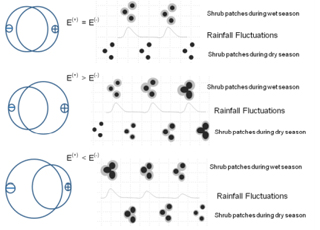Self-Organization in Patch Pattern Dynamics by Spatial Embeddedness
(Israel Science Foundation Research 2012-2015)
Self-organization is a crucial life-supporting mechanism facilitating the evolution of equilibrium and order. Yet, in general, there is much confusion regarding its terminology, and in particular, regarding self-organized and emergent behavior. Self-organization has a prominent spatial dimension with a most distinctive representation in two-dimensional patch patterns, which are abstractions of a wide range of spatial phenomena. Despite the dominant role of spatial mechanisms in self-organization, relatively few studies have addressed the self-organization phenomenon in geographical science in general, and in geo-information science in particular. The proposed research presents a geoinformation approach for studying spatial mechanisms underlying self-organization and its implementation in semi-arid shrublands. It is suggested here that embeddedness, which represents the formation of spatial memory, facilitates self-organized behavior. Where embeddedness takes place during cycles of rainy and dry seasons, it is suggested here that such embeddedness differentiates between self-organized and emergent types of behavior. Differentiating between positive and negative embeddedness allows one to describe and assess local self-organization as well as convergent and divergent types of such organization at the wide regional scale, with significant implications regarding the stability and order of patterned environments.
The proposed study will implement geosimulation based on a cellular automata technique representing modes of shrub extension and spread as well as the formation of soil property gradients representing spatial embeddedness. The parameters for simulating a wide range of scenarios, combined by different rates and modes of positive and negative embeddedness, are derived from exciting published studies as well as from remote sensing. The remote sensing part includes close-range imaging using sensors in the visible, NIR, and thermal wavelength bands as well as processing historical aerial photographs for assessing the climatic gradient of the Judean mountains incentral Israel. Similarities/ dissimilarities in modes of change in embedded soil forms and shrub patch patterns will be analyzed for assessing the local as well as the converging and diverging forms of self-organization.
References:
- Shoshany, M., 2009, Self-Organization of Patch Patterns Evolving across Climatic Gradients: Theory and Implementation. 6th International Symposium on Digital Earth (ISDE6), Beijing, September 2009.
- Shoshany, M., 2012, Self-Organization in Shrublands’ pattern along a climatic gradient: A geo-simulation and remote sensing study. European Geoscience General Assembly (Session SSS6.9), April 2012 Wien, Austria.

